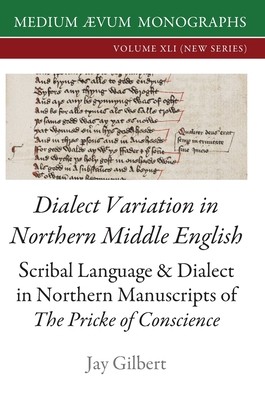
- We will send in 10–14 business days.
- Author: Jay Gilbert
- Publisher: Medium Aevum Monographs / SSMLL
- ISBN-10: 1911694057
- ISBN-13: 9781911694052
- Format: 14.8 x 21 x 1.9 cm, hardcover
- Language: English
- SAVE -10% with code: EXTRA
Reviews
Description
This book investigates the concept of the Northern Middle English dialect area as largely homogenous, taking its core data from four Northern manuscripts of the devotional poem, The Pricke of Conscience. The NME area has been little studied, due largely to a lack of localised manuscripts. A Linguistic Atlas of Late Mediaeval English is an invaluable resource for the dialectologist, but where anchor texts are lacking, it cannot form a sole basis for study. This book approaches dialect study in the region from a different angle, compiling and comparing linguistic data from its core manuscripts to determine what variation can be observed. Each manuscript is also considered in its codicological and sociolinguistic context, using scribal behaviour as a means of illuminating the possible provenances of manuscripts and their language types. Finally, the data is considered alongside similar information from edited texts from this region, to place it in its proper context and examine what patterns of variation emerge. The findings of this study show a greater range of variation across the NME region than traditional descriptions would indicate. The variation attested demonstrates that some features previously held to be 'non-northern' or anomalous are, in fact, organically and consistently in use in this area. It identifies and describes five observable NME language varieties. The combination of textual and codicological evidence enables suggestions to be made about the identity of several of the scribes examined, connecting language varieties to occupation and possible provenance. This book presents a more nuanced, heterogeneous picture of the NME region, which may serve as a basis for further study in the area.
EXTRA 10 % discount with code: EXTRA
The promotion ends in 20d.04:38:38
The discount code is valid when purchasing from 10 €. Discounts do not stack.
- Author: Jay Gilbert
- Publisher: Medium Aevum Monographs / SSMLL
- ISBN-10: 1911694057
- ISBN-13: 9781911694052
- Format: 14.8 x 21 x 1.9 cm, hardcover
- Language: English English
This book investigates the concept of the Northern Middle English dialect area as largely homogenous, taking its core data from four Northern manuscripts of the devotional poem, The Pricke of Conscience. The NME area has been little studied, due largely to a lack of localised manuscripts. A Linguistic Atlas of Late Mediaeval English is an invaluable resource for the dialectologist, but where anchor texts are lacking, it cannot form a sole basis for study. This book approaches dialect study in the region from a different angle, compiling and comparing linguistic data from its core manuscripts to determine what variation can be observed. Each manuscript is also considered in its codicological and sociolinguistic context, using scribal behaviour as a means of illuminating the possible provenances of manuscripts and their language types. Finally, the data is considered alongside similar information from edited texts from this region, to place it in its proper context and examine what patterns of variation emerge. The findings of this study show a greater range of variation across the NME region than traditional descriptions would indicate. The variation attested demonstrates that some features previously held to be 'non-northern' or anomalous are, in fact, organically and consistently in use in this area. It identifies and describes five observable NME language varieties. The combination of textual and codicological evidence enables suggestions to be made about the identity of several of the scribes examined, connecting language varieties to occupation and possible provenance. This book presents a more nuanced, heterogeneous picture of the NME region, which may serve as a basis for further study in the area.


Reviews